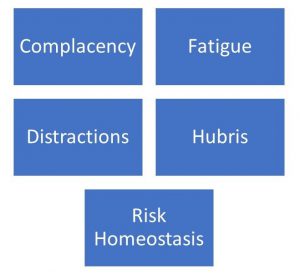Editor’s note: This article is part of a series. Click here for the previous article.
Gordon Graham here and welcome back to our discussion on why public safety personnel make mistakes on high-frequency, high-risk events. In an earlier article, I identified five root causes that keep popping up. They are:

We discussed complacency and fatigue, so as I promised last time, this article will provide some thoughts on the danger of being distracted when you are doing things that require focus and attention.
My career in law enforcement started 47 years ago, in 1973. After graduating the California Highway Patrol (CHP) Academy—and before I was assigned to motorcycle duty—I drove a Dodge Polara.
The “Big Dodge” the CHP used in the 60s and early 70s was the result of CHP Sergeant Bob Phillips and a very interesting fellow named Rex Sagle. Rex was the guy who worked diligently to make sure the Dodge was set up right in terms of wheelbase, suspension, steering and other engineering issues. His work in linking what the CHP needed and what Dodge could engineer was simply fantastic.
As I rode along with the CHP officer, I could not help but notice that he spent a lot of time typing and driving.
I met Rex at an ALERT conference several years ago and we became good friends with a common interest in fast cars. Even at more than 80 years of age, he was very sharp and up to date on all the goings-on with the Dodge Demon and other current products. American law enforcement lost a good friend when he passed away, but I will always remember his great work in making CHP officers safer.
But back to the Dodge Polara. If you opened the hood of the Dodge Polara in 1973, you were greeted with the massive 440-cubic-inch engine. (For the young people reading this who are asking, “How many liters is that?” there are roughly 61 CI per liter, so 440 CI would equate to roughly 7.4 liters—and while you don’t know this, I did that calculation in my head because I went to Catholic schools and if you could not divide in your head you got beat by a nun. So I can divide without using a calculator, and I dazzle my two kids with my ability to calculate mpg when I fill up my tank, which rarely goes below half-full because that is what my dad taught me in the 60s and he was a smart guy—but enough of that.)
Remarkably, when you looked at the Big Dodge motor, you could see the ground—no kidding—and if you dropped a tool while working on the motor, it would fall to the ground and you could pick it up from under the car. Contrast that to the aforementioned 2018 Dodge Demon—when you pop the hood all you see is “stuff.” You cannot see the ground and if you drop a tool, it will disappear into all the stuff and that tool is gone forever.
Yes, the new cars are very, very complex under the hood. But let’s go back in time and look at the interior of the Big Dodge. It had a bench seat (which is just about unheard of today; you young kids have no idea what could be accomplished on a bench seat, but the old people reading this are smiling if not laughing) and a radio mounted on the transmission tunnel with the mic hanging on a slide hook on the dashboard. There was a toggle switch on the dashboard to activate the rear deck lamps (up for red and down for yellow) and a second toggle switch that allowed the horn ring to activate the “growler” siren (look it up on YouTube) and a hand-activated “ruby” mounted on the driver’s side A pillar.
The Big Dodge also featured a manual engine-throttle pull lever so you could increase the RPM on the vehicle when it was in park—and you were out of the vehicle working a wreck or writing a cite—to keep the engine running fast enough to keep your headlights on at night (I am not making this up). Throw in a floor-mounted Remington 870 WingMaster with the hidden “electro lock” release switch, and that was just about all that was in the Big Dodge from four decades ago.
Remarkably, when you looked at the Big Dodge motor, you could see the ground—no kidding—and if you dropped a tool while working on the motor, it would fall to the ground and you could pick it up from under the car.
Again, contrast that to the new Dodge Charger interior. A couple years ago I was in a brand-new CHP Hemi Charger and my gosh I was shocked! Laptop computer, massive screen, radar devices, shotgun, automatic rifle, recording devices, radios, scanners and enough switches and buttons to resemble the 747 cockpit! As I rode along with the CHP officer (who looked like he was not old enough to have a license to drive), I could not help but notice that he spent a lot of time typing and driving. During our very brief time together there was some unnecessary heavy braking because he was not only looking at the screen, but also the keyboard while simultaneously driving the car, and he failed to have an adequate cushion of space between his patrol car and the vehicle in front of us.
I made a comment to his Sergeant (whose mother worked on my shift when I was a Sergeant in the 80s) and his response was “Yep, that is a big problem and we have a lot of collisions because of it.” For those of you really into this, in 2016 a CHP officer was prosecuted for killing a 15-year-old kid in a collision involving distracted driving.
It is not just the computers that cause distractions. Cell phones and other handheld devices are huge distractors—you can be distracted as a pedestrian or even just standing and talking on a cell phone. Looking for criminal activity while you are driving is a distraction. On the CHP we had motorcycle cops on Sunset Boulevard getting in wrecks because they were distracted—not because of the gorgeous people who were walking down the sidewalk, but because they were looking at their reflection in the storefront windows! I am not making this up!
Well, I just did the word count on this and my rambling is now over the 1,000-word mark—and the editor of this piece is very concerned about the word count, but she is not a nun so I don’t have to worry about getting hit with the ruler for going over the limit. In closing, I would like you to think about the distractions you face as a dispatcher, patrol officer, firefighter, EMT/paramedic, PIO, SWAT cop and all the other jobs that you will find in a municipal public safety agency.
More importantly, how are you going to control these distractions so you do not end up in some tragedy?
I look forward to the next article, which will explore hubris and the associated dangers. Until then, please work safely.
 TIMELY TAKEAWAY—I make it a point to put my cell phone in my briefcase and my briefcase in my trunk while I am driving. I know me: If it is handy, I will probably use it and sooner or later that will cause me a problem. Oh, I could probably get away with it occasionally, but when the deviation becomes the norm, that is a ticket for tragedy. What do you do to ensure you’re not tempted by your phone when you’re behind the wheel?
TIMELY TAKEAWAY—I make it a point to put my cell phone in my briefcase and my briefcase in my trunk while I am driving. I know me: If it is handy, I will probably use it and sooner or later that will cause me a problem. Oh, I could probably get away with it occasionally, but when the deviation becomes the norm, that is a ticket for tragedy. What do you do to ensure you’re not tempted by your phone when you’re behind the wheel?